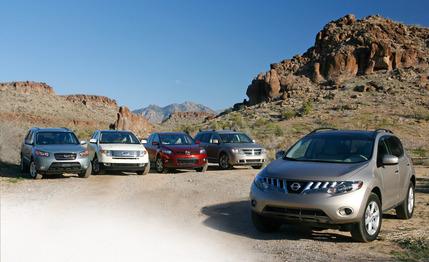
 Comparison Tests
Comparison Tests
Every road cut tells a story. When the interstate goes in, road builders slice away hills and mountains, leaving walls of soil and rock assembled over millions of years. Each wall tells a story of earth’s evolution. All you need is an interpreter. Geologist and author Wayne Ranney joined our trek in Flagstaff, Arizona, as we headed west on Interstate 40. He snicked his seatbelt and began reading the cuts panning by the side windows as if they were ancient billboards.
“We’re cutting through a lava flow now,” he said, gesturing toward the chunky brown ledges looming gloomily on each side of the highway. “This is basalt, earth’s most common type of rock.”
The area around Flagstaff was hyperactive volcanically, he explained, 600 vents in the 30-some-mile space west to Williams. Dark and forbidding rocks pepper the ground when they aren’t actually laced into the terrain. “The last eruption was only 940 years ago.” No need for satellite radio when Ranney is riding shotgun.
Arriving from various compass points, we’d gathered in Sedona, Arizona, the night before, five staff drivers and two dudes from the art department. With crude oil rising past $110 per barrel, there was an urgency about this mission. Car buyers are shunning old-style body-on-frame SUVs; too heavy and fuelish. Oddly, we’d never compared their logical replacements, the mid-size car-based utes called “crossovers.” Until now.
Two of the five choices on this drive are hot-from-the-oven 2009 models. Dodge has the freshest idea, the Journey, based on Chrysler’s mid-size Avenger/Sebring platform. Arguably, given the passenger-car soul, crossovers are the return of the family wagon. With its sharp-edged roofline and high-definition body sculpting, Dodge has expressed crisp in this new model in a way that says “no way” to the other oh-nine in the bunch, Nissan’s rebake of the Murano.
Formerly a soft shape, the redesigned Murano has morphed into a me-too Michelin man, all puffy and over-inflated, like 50 psi in a balloon intended for half that.
The pressure is up inside, too, with huffed-up shapes on the dash and door panels. With Nissan’s muscular 3.5 V-6 as standard equipment, you can be sure of one thing: This bubba will boogie.
The three other crossovers in our quintet have been around long enough since their 2007 intros to have become thoroughly familiar faces in traffic. The blocky Ford Edge seems to stand tall on the road, a tidy, muscular look that sold 130,125 copies in its first full year in the stores. A discreet distance behind at 92,421 sold is the Hyundai Santa Fe, substantially enlarged during its last redesign. Well behind at the checkout counter is Mazda’s CX-7, a sweetheart to look at, powered by the only four-cylinder of the group, a turbocharged 2.3-liter with direct injection.
All our test crossovers have the option of all-wheel drive. The Dodge and the Hyundai are available with third-row seating, although we did not include that capability in this test.
What about fuel economy? Federal watchdogs rate the Nissan highest for city driving at 18 mpg. The Dodge and the Ford tie for thirstiest at 15 mpg. On the highway, the Hyundai tops the tote board at 24; the Dodge, the Ford, and the Mazda bring up the rear in a three-way tie at 22 mpg.
When we picked up geologist Ranney in Flagstaff, elevation 7000 feet, we were on the western edge of the Colorado Plateau, a relatively stable area of the continent where the Four Corners of Arizona, Colorado, New Mexico, and Utah come together. Immediately to the west is the Basin and Range region, where a stretching of the earth’s crust in ancient times resulted in the sinking of a broad area including Phoenix and Las Vegas. So we’d be driving downhill over the 144 miles to our destination that night, Kingman, Arizona, elevation 3300 feet. Along the way we would take notes, change cars, and stop to hear Ranney read off the geological stories captured in the many road cuts along I-40.